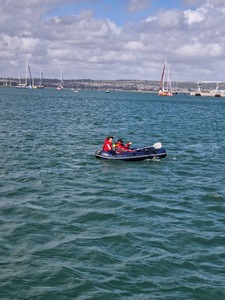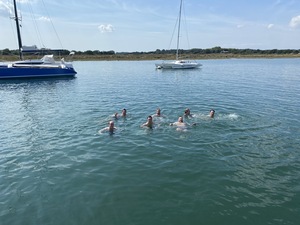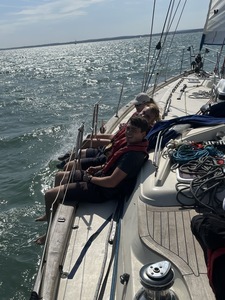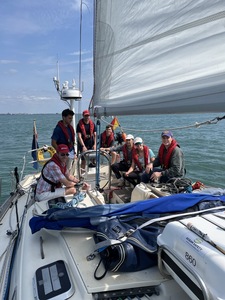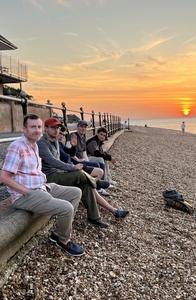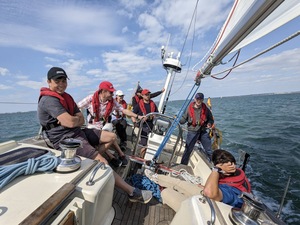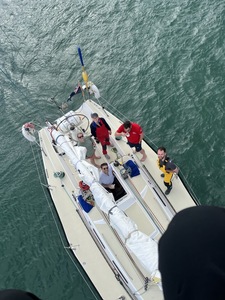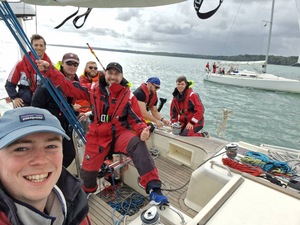Introduction
Across two long weekends (22-24 August and 29-31 August) 13 members of the Royal Yeomanry took part in sailing training in the Solent. Of these one was a qualified sailing instructor and three (having been able to attend both weekends) achieved the necessary requirements to gain the Royal Yacht Association (RYA) Competent Crew (CC) qualification. The trip was also supported by two qualified day skippers (one from Exeter OTC and one from 101st Regiment Royal Artillery) who came along to ensure that minimum crewing requirements were met and a cruising instructor from the Royal Wessex Yeomanry.
Day 1
An early start was in order to make sure the soldiers of C and F Squadrons made it from Croydon to the marina in Gosport by 0900. Upon arrival, we took over the St Barbara V, a 42’ yacht from the Royal Artillery Yacht Club. Once the initial safety briefs had been delivered and the food and bags loaded the skipper and first mate delivered a lesson on line throwing – an essential skill when mooring up. Thereafter, we slipped lines and set off into the Solent, our destination being East Cowes Marina. The Sun was shining and the conditions were perfect for a novice crew, calm enough to be safe but breezy enough to get some sailing in. This leg being into the wind the focus was on how to tack and understanding the rules of priority and passing in a busy waterway. A lunch of sandwiches and crisps was prepared in the galley and enjoyed underway whilst people rotated through different jobs on deck. We arrived into Cowes at around 1730 and got the chance to put the earlier lessons into practice as we moored up. Once the boat was put to bed the crew caught the ferry to West Cowes to enjoy a well-earned BBQ on the beach, celebrating what was a successful and thoroughly enjoyable first day.
Day 2
We set sail from West Cowes under clear skies, heading east across the Solent toward the River Hamble. We took time to practice an essential skill—mooring to a buoy. With our skipper guiding us through the process, we rotated roles and refined our technique, gaining confidence in handling the boat under close control.
Once anchored securely, we waited for a space in Hamble River Harbour for the night. Several of us used this down-time to launch the tender boat and went exploring along the quieter stretches of the river, whilst the rest of the crew enjoyed a well-deserved swim in the calm waters. It was during this peaceful excursion that we spotted a group of seals lounging near the banks, their sleek heads staring curiously by the water. Drifting quietly nearby, we watched them for a while, enjoying the rare chance to observe them up close in their natural habitat.
Back on board and into the harbour, the evening unfolded with a mix of well-earned relaxation and hearty food. Our dinner—an ambitious six-hour roasted chicken—was finally ready after a slow cook in the yacht’s temperamental oven. After eating, we ventured ashore to explore a few of the quaint pubs dotted around the Hamble, soaking in the local charm and swapping stories from the day. The night ended with a nostalgic outdoor screening of Top Gun, the sound of jet engines and 80s anthems echoing across the marina as we settled in under the stars.
Day 3
We woke up in Mercury Harbour on the River Hamble to a calm morning and the smell of bacon rolls frying in the galley. Over coffee and breakfast, Max guided us smoothly out of the Hamble under motor, the rising sun catching the masts around us as we left the busy river behind. As we motored through away from Southampton, we passed enormous cruise ships dwarfing our little yacht, their size a striking contrast to our own steady vessel.
Once into the Solent, we hoisted the sails and settled into a steady rhythm of tacking. With the tide running against us and the wind blowing across our course, we zigzagged our way toward Gosport. Speed was key—any hesitation risked losing momentum in the turn—so fast, coordinated winching from the team was vital. Each tack became a drill in timing and communication, the boat heeling as we powered through the chop. The rush of water along the hull mixed with bursts of laughter as we sharpened our technique and learned to anticipate each wind shift.
By late afternoon, the familiar outline of Gosport came into view. We sailed into the marina tired but exhilarated, the weekend’s challenges leaving us with a real sense of progress and accomplishment. After the boat was properly put to bed we set off back London.
Day 4
Once again, it was an early start to get from London to Gosport. This weekend, an additional yacht, White Knight 7 a 36’ yacht from the Royal Armoured Corps Yacht Club (RACYC), joined St Barbara V allowing for a total of 12 personnel to get out on the water. Once the boats had been taken over St Barabra V led the way out into the Solent. However, with winds measuring seven gusting eight on the Beaufort scale, our skipper made the prudent decision to turn back and wait for calmer weather. Luckily, the conditions in Portsmouth Harbour were good enough that both crews could get in plenty of practice tacking, gybing and catching mooring buoys. By 1730 the wind had dropped enough that both boats were able to set off for Cowes Yacht Haven. Going against the wind, progress was gradual and both boats were sailing well after dark – a requirement for those wishing to gain the RYA CC qualification. The night sailing provided a great opportunity for the crews to work on their communication and seamanship, with even the simplest of tasks becoming far more challenging. Dinner was enjoyed underway and the clouds cleared to reveal a fabulous set of stars as we pulled quietly into the marina at around 22:30. It’s fair to say everyone was exhausted after a long day of sailing and once the boats were put to bed the crews weren’t far behind.
Day 5
We started the day early after a hearty breakfast that gave us the energy for what lay ahead. By 8:30 in the morning we had slipped lines and departed from Cowes Yacht Haven, setting a steady course toward Southampton Marina. Our aim was to arrive before 2:00 p.m., as a storm was forecast later in the afternoon, and everyone was focused on making the passage in good time.
Fortunately, conditions were on our side. A consistent wind of around 7 knots carried us smoothly across the water, while sea state 3 added both challenge and excitement to the journey. The crew worked together to keep the boat balanced and on track, and we found that the combination of steady winds and teamwork meant we reached our destination ahead of schedule—by about half an hour. This early arrival felt rewarding and gave us some breathing space before the storm approached.
Once securely berthed in Southampton Marina, we gathered for a lesson led by Mr. Gimlette. He introduced us to some essential sailing knots: the bowline, the figure eight, the reef knot, and the half hitch. Each knot had its own purpose and technique, and it was a very educational moment that strengthened our practical seamanship skills. Afterward, we were shown how to prepare the boat for stormy conditions while inside the marina, which was an invaluable exercise in safety and readiness.
With the day’s duties complete, we took time to explore Southampton as a group. We wandered through the city and eventually visited an aviation museum, where the exhibits provided a fascinating contrast to our maritime experiences. It was a full and memorable day of learning, teamwork, and discovery.
Day 6
On White Knight 7, we woke early in the calm of Southampton’s Ocean Village Marina, where we had sheltered overnight from a howling storm. After preparing for the day, we slipped our lines while being helmed by a crewmember learning how to reverse out of tight berths, a wholly new experience for them. On clearing the marina we focused on a new technique for us of raising the mainsail while close-hauled as we were forced to tack down a narrow channel. This required us to focus on clear communication and teamwork for an outside-the-box method. Once the foresail was also unfurled we set our course for Portsmouth and were delighted to find ourselves on a single tack for most of the way giving us ample time to cook a hearty supply of bacon – a crew favourite – during the steady passage. Upon arriving in busy Portsmouth, the skipper introduced the crew to a lesson on pick up buoys, giving everyone valuable practice in a core seamanship skill. After a couple of role swaps around the boat lunch followed – a substantial series of omelettes cooked by the Skipper, Matthew Pollard of the RWxY. With renewed energy we took the opportunity to explore upriver towards the aging warships moored near Fareham. This also allowed us to offer a final training opportunity to those less confident at the helm along tight and lively waterways. By the end of the day, the boat was moored back in its home berth at JSASTC in Gosport and the crew enjoyed reflecting on the progress made and the rewarding challenges overcome, both individually and as a team.
Competent Crew Student Perspective
The overall aim of the Competent Crew course was to introduce us to the fundamentals of sailing, seamanship, and teamwork at sea. From the very beginning, the emphasis was not only on learning practical skills but also on developing the confidence, awareness, and adaptability needed to contribute effectively as members of a crew.
Throughout the course, we gained hands-on experience in a wide range of areas. These included helming under different conditions, sail handling, basic navigation, safety procedures, and ropework. One particularly valuable lesson was knot-tying, where we learned the bowline, figure eight, reef, and half hitch knots and their practical uses onboard. We also took part in preparing the boat for stormy weather inside a marina, which highlighted the importance of readiness and attention to detail in maintaining safety. In addition, we practiced using the dinghy both for emergency drills and for moving around, which gave us confidence in handling smaller craft. We also learned about anchorage procedures and carried out man overboard drills, where teamwork and quick reactions were crucial.
The course presented both physical and personal development challenges. Working in confined spaces required patience and clear communication, while sailing in stronger winds and level 3 waves pushed us to remain calm and focused under pressure. At times, tasks felt unfamiliar and demanding, but we came to see that persistence and mutual support were key to overcoming them.
These experiences have given us a strong foundation in seamanship and instilled greater resilience, teamwork, and discipline. Going forward, this training will allow us to contribute more effectively in maritime environments and to approach challenges within the regiment with improved problem-solving, confidence, and adaptability. Ultimately, the course has developed not only our sailing skills but also our ability to operate as a cohesive and reliable team.
One of the students, Tpr Chimski said this of his time on the course
“It has been really interesting to do something different with the Army Reserve and I feel I have learned a huge amount, not just about sailing but also about how to work in complex and unfamiliar environments.” Another of the students, LCpl Muspratt, described the training as “the perfect mix, challenging enough to stretch us at times but also a great way to relax and switch off from the stresses of everyday life.”
Summary
Two long weekends sailing in the Solent provided the perfect opportunity for the soldiers of the Royal Yeomanry to come together and enjoy a challenging and exciting period of training outside of their normal Army Reserve commitment. The trip not only developed the groups nautical skills but also helped improve our communication, at times pushed us out of our comfort zones and helped bring further cohesion across the regiment. The Royal Yeomanry owes thanks to the Royal Armoured Corps and Royal Artillery yacht clubs for entrusting us with their yachts, 101st Regiment Royal Artillery Regiment, Exeter OTC and the Royal Wessex Yeomanry for prodivding qualified sailors and to the Ulysses Trust for supporting the trip and helping ensure it was accessible to as many personnel as possible.

